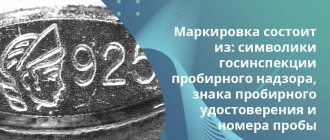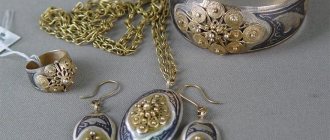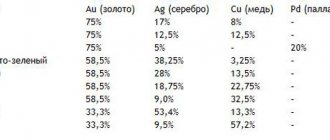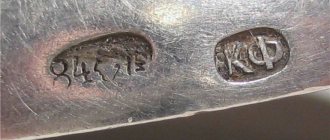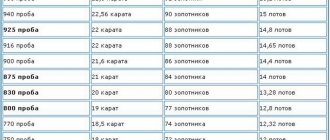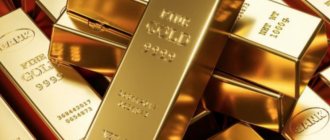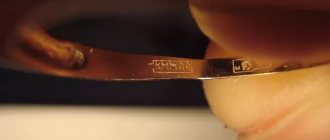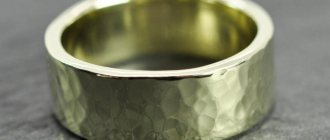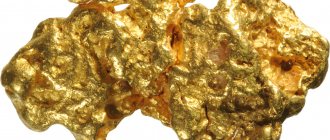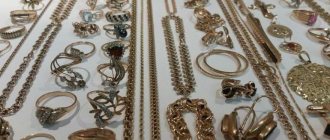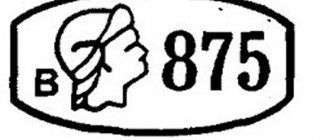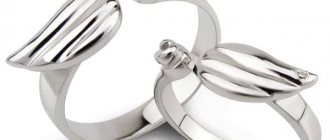What is 84 sterling silver: composition and properties
84 silver standard can be found on ancient products that were hallmarked in accordance with the spool hallmark system. In Russia, this system was used until 1927, after which it was replaced by the metric method of calculation.
The spool system was introduced into Russia from the very beginning of hallmarking precious alloys, in 1798. Its basis was the Russian pound, containing 96 spools.
Sample 84 on the product reported that one pound of such an alloy contained 84 parts of pure precious metal, and the remainder was impurities. Pure silver was considered to have a value of 96, therefore, foreign elements made up only 12 parts of this alloy.
Silverware
The material could contain the following impurities:
- Cadmium;
- Zinc;
- Nickel;
- Aluminum;
- Copper;
Depending on the percentage of elements, the alloy could have different casting and performance characteristics. For example, thanks to cadmium, the alloy melted more easily, nickel imparted hardness, and copper increased wear resistance.
84 silver contains 87.5% pure precious metal. It does not fade, does not deform, and is resistant to mechanical damage. Thanks to the impurities included in the composition, it is much stronger than pure silver.
Rules of care
Those who are lucky enough to own antique silver should remember some rules for caring for it. After use, dishes and cutlery are washed in warm soapy water, rinsed thoroughly and left to dry. Only after the product has completely dried can it be wrapped in a soft cloth and removed. Such devices should not be stored in rooms with high humidity.
Jewelry made from this alloy darkens when it comes into contact with human skin. Several decades ago, such a reaction was considered a disease or damage. But everything is much simpler. Sample 84 contains copper, which reacts with sulfur oxide released by the human body through sweat. Therefore, to prevent jewelry from quickly fading during work or sports, it is better to remove it.
If the silver item does become dark, it can be cleaned with salt or soda. Each of the products can be used either separately or mixed. If the plaque is strong enough, then you need to mix soda, ammonia and toothpaste. Then, using a brush, apply the mixture to the product and wait a little. When the item takes on its original appearance, rinse it and wipe it dry with a paper towel or napkins.
Any 84 sterling silver item will be an excellent gift for both a friend and a loved one. After all, such an expensive and original gift will be remembered for a lifetime.
Changing the mark on antiques 84 samples
On 84 sterling silver the mark looked like this:
- Numerical value of the sample;
- Imprint of a woman's profile in a kokoshnik;
- Initials of managers or foreman;
The brand was changed in 1908: the girl’s profile was turned from right to left, it was allowed to mark the year of manufacture, and it was also required to indicate the code of the production area.
For example, the stamp “84 OS AC 1985” should be read as follows: 84 spools, OS are the initials of the master, AC are the initials of the owner of the company, 1985 is the year of manufacture.
The 84 mark on silver usually looks like a rectangle with rounded edges, inside which information about the product is written.
Stamp marks could also be indicated on silver items. For example, an imprint of St. George the Victorious slaying a beast with a spear indicates that the jewelry work was tested in the Moscow Assay Office.
How much silver is in the 84th standard?
Establishing the ratio of the metal itself and cheap additives in 84-carat silver will not pose any problems. The number 84 means that this alloy contains 84 spools of silver per pound. In total, the Russian pound contains 96 spools. Then, dividing 84 by 96 and multiplying by 100, we obtain a silver content of 87.5%. Switching to a modern assay system, we find that 84 hallmark silver is an exact analogue of the current 875 hallmark of this metal.
Products with 875 silver purity still exist today and are no less popular than they were 100–200 years ago.
Silver spoons 84 samples
The use of the royal sample then and now
Nowadays, 84 sterling silver is used to create cutlery, inexpensive jewelry, jewelry boxes, ashtrays, and souvenirs. The material has high strength, so it is used for products subject to constant physical impact.
Antique royal silver was used to create the following items:
Crockery and cutlery
The popularity of silverware peaked between 1840 and 1940, as trade between countries expanded during this period. Tsarist Russia produced a wide variety of silver utensils: spoons, forks, knives, cups, plates, deep dishes, decanters, teapots, coffee pots. Serving the table with precious cutlery was considered a rule of good manners among the nobility.
Antique tableware made of 84 sterling silver
Silver kitchen utensils were valued for their antibacterial properties, status, and lack of toxic effects on the body.
Decor items
The hallmark of 84 sterling silver can be seen on candlesticks, vases, glass holders, and frames. Russian master jewelers indicated their initials on such items, and the work itself was performed using casting and carving techniques.
Vintage collectibles
Such jewelry works include cigarette cases, boxes, and figurines. Crosses, icons, and coins of pre-revolutionary Russia with 84 markings are of great value to collectors.
Accessories
The alloy was used to cast rings, earrings, necklaces, bracelets, rings, and chains. Nowadays such material is almost never used to create jewelry. The most popular modern standard is 925.
Of particular cultural and historical value are items produced by the jewelry companies of Khlebnikov, Sazikov, Ovchinnikov, and Postnikov. These famous workshops appeared in the 17th century. They were distinguished by the production of truly masterpiece products, worthy of nobles and kings.
Common antique samples
The spool system was in use from the beginning of assaying precious metals until 1927. The increase in silver content in the product and its cost depended on the sample. , the following symbols could be found on jewelry and cutlery
- 72 spools. The weight of silver is 0.750 of the total weight, which corresponds to modern 750 fineness. Until 1867, coins of 5, 10, 15 and 20 kopecks were minted from this alloy, but now it is used only in industrial production. 750 silver is used to make needles, springs and other products that operate under high loads.
- 84 spools. The specific gravity of the precious metal is 0.875 of the mass of the object. In the metric system this corresponds to 875. 84 sterling silver hallmarked by Tsarist Russia was used to make various household and household items (cup holders, spoons, boxes, cigarette cases, etc.), as well as jewelry - rings, earrings, chains. Products marked with this mark were most often found on the market, but only a few of them have survived to this day.
- 88 spools. The weight of silver is 0.916 of the weight of the alloy (metric 916 standard). In the USSR, 916 precious metal was actively used in the jewelry industry, but after some time it was replaced by a higher quality alloy - 925.
- 90 spools. The precious metal content is 0.937 of the total weight. In the metric system this corresponds to 937. Initially, jewelry and household items were made from such silver, but later the sample was considered unsuitable for production and was abolished.
- 91 spool. The specific gravity of silver is 0.947. At the moment, there is no sample corresponding to this value - it went out of use back in Soviet times.
- 96 spools. The weight of the noble metal is over 0.999, which corresponds to the modern value of 999. Silver of this standard contains virtually no impurities, but is almost never used for making jewelry due to its tendency to deform. In everyday life, it is used for the manufacture of parts for various devices and the production of solders.
Table: cost of 1 gram of modern analogue
The cost of any alloy depends on the price of pure precious metal established by the Central Bank of the Russian Federation. To determine the current cost of the sample, you need to multiply the current price of the highest alloy by the required coefficient.
The price of pure silver for 2022 is about 47 rubles per gram. 84 marking corresponds to modern 875 standard.
Then you can calculate the current cost of the royal analogue as follows:
47 * 0.875 = 41.1 rubles per gram.
The table below shows the approximate cost of the precious metal in pawnshops, jewelry stores, and banks:
| Price 999 standard according to the Central Bank of the Russian Federation, rub. | Market value of 875 samples, rub. | Scrap price, rub. | Price in jewelry boutiques, rub. |
| 47 | 41,1 | 3 | 60 |
Price
The price of silver, like other precious metals, changes quite often. Although it is worth noting that compared to gold or platinum, this is the most stable alloy. Over a couple of years, the price per gram of metal changed by an average of five rubles and ranged from 25 to 30.5 rubles.
You can find out the current cost for a specific day in the reports of the Central Bank of Russia. Prices at pawn shops or antique markets may vary. But all this applies to silver in general, because... The 84-karat alloy is valued based on the antique value of the item.
Where can you find 84 samples today?
There are many websites on the Internet dedicated to products made from the royal precious metal. The most famous resource is the Volmar auction, where you can purchase various numismatics and antiques.
Utilitarian jewelry works from ordinary and famous workshops are sold many times cheaper than rare collectibles. The cost of the latter can reach several hundred thousand rubles.
Glass made of 84 sterling silver
You can buy 84 sterling silver products at various exhibitions dedicated to the era of the USSR and Tsarist Russia, from buyers, antique dealers, and at flea markets.
Antique value
Antique hallmarked 84 silver items are highly valued both culturally and historically, and are worth much more than their modern 875 counterparts. A high valuation value is determined not so much by the presence of a mark, but by the condition of the item - for example, the antique value of spoons with a curved edge or earrings with broken temples will be zero, and they can be sold solely by weight.
When buying 84-carat silver, a qualified examination is usually carried out to determine the authenticity of the product and understand its estimated value. The condition of the items being sold is considered a key factor in pricing. In addition, a huge role is played by:
- Execution level . Silver products, in the manufacture of which complex techniques such as blackening or enameling were used, as well as jewelry equipped with complex openwork elements, are always more expensive.
- Rarity level . Items produced in the USSR are found much more often than antique ones, which cannot but affect the cost. At the same time, it is important to remember that even among antique products there may be so-called consumer goods, which at one time were produced in large quantities.
- Completeness . Complete sets of cutlery and parures are valued much more than their individual components.
Well-preserved vintage items are of interest to many wealthy collectors who are willing to shell out up to 1,000 rubles for each gram of antique silver. The cost of some jewelry and household items can reach 100 thousand rubles. You can find prices for 84-grade items in the catalogs of antique stores.
Rules for storing and delicate care of products 84 samples
Antique metal should be stored very carefully. Caskets or boxes with a solid frame and soft upholstery inside are suitable for this purpose.
Products with 84 markings should be stored separately from other jewelry. The place should be dry; moisture-absorbing materials, for example, activated carbon, silica gel, can be placed inside the box.
If jewelry is encrusted with precious stones, you should use specialized cleaning products to care for the minerals.
Products may fade from regular wear and over time. It is recommended to clean them with a mixture of salt and soda. The components are mixed in identical proportions, applied to the products, after 1-2 hours the jewelry will need to be thoroughly rinsed with running water.
Important! Silver is harmed by household chemicals, some medications, perfumes, cosmetics, and acids. Products should be protected from contact with the listed substances.
Products made of sterling silver 84
The insufficiently high content of the precious metal itself in the 84th sample of silver was the reason that jewelers rarely used it as a material for jewelry. But its resistance to external influences and the ability to restore the natural silver color made it possible to make household items of great artistic significance from it:
- caskets;
- cigarette cases;
- cup holders;
- serving trays;
- cutlery.
When a dark coating formed on such products over time, it could be easily cleaned off without fear of scratching the product itself. A simple cleaning completely restored the color of real silver.
Although many items with an 84-carat silver hallmark could be used for household needs, they more often served as a kind of advertisement for the wealth of their owners. According to its characteristics, this alloy occupied a convenient price niche. It was not so expensive that it was available only to a select few, but also not so cheap that it was purchased by ordinary citizens. Therefore, silver of 84 purity was a widespread indicator of wealth. To increase prestige, some products made of this metal were plated in places with gold. Silver boxes and snuff boxes with internal gilding looked especially impressive. It's silver on the outside, but when you open it, it's a glitter of gold.
Silver cup holder 84 samples
Reviews
I found silver at the dacha, saw the mark 84 on a product for the first time, and went online to find out what it could mean. It turned out that I had a real treasure in my hands - a powder compact from the times of Tsarist Russia! I kept it for myself and will become a family heirloom.
Vitaly A., Pyatigorsk
Lydia Sh., Kislovodsk
I got a silver sugar bowl from my grandmother. The stamp inside is “84 TR 1830”, a horseman is depicted next to it. I took the product to a buyer, where they told me the approximate price of this antique - 50 thousand rubles. I'm thinking of selling it in a couple of years, when the value rises a little more.
I saw a name on the glass holder - “silver 84 AG VNR”, next to it was an imprint of a woman. I would never have thought that all this time I had such an antique in my apartment. Now I try to take care of it regularly and use it very rarely.
Richard N. g, Vladikavkaz
USSR
As I wrote above, the spool system was also used in the young Soviet state. In 1927 it was replaced with a more convenient one - metric. It is based on the amount of noble metal in milligrams per 1 gram of alloy. It can also be represented as parts of silver per 1000 parts of the alloy being tested, just like in school math problems. The young lady in a kokoshnik next to the sample was replaced with the head of a worker with a hammer. Here, as under the king, a symbol from the Greek alphabet was affixed. And since June 1958, instead of a worker, they began to use the image of a five-pointed star with a hammer and sickle inside. It was also decided to replace Greek letters with Russian ones. Thus, the jewelry industry of the Soviet Union used six samples of silver:
- 750;
- 800;
- 875;
- 916;
- 925;
- 960.
The manufacturer's mark was also placed next to the indication of the amount of pure silver in the alloy and the star. The most common alloy in products is 875 alloy. This is confirmed by various finds of instrument search enthusiasts: earrings, rings, bracelets, and jewelry sold in antique shops. In addition, in the fall, on the farm, I was lucky enough to dig up a silver bracelet. So it also had 875 standard on it.
